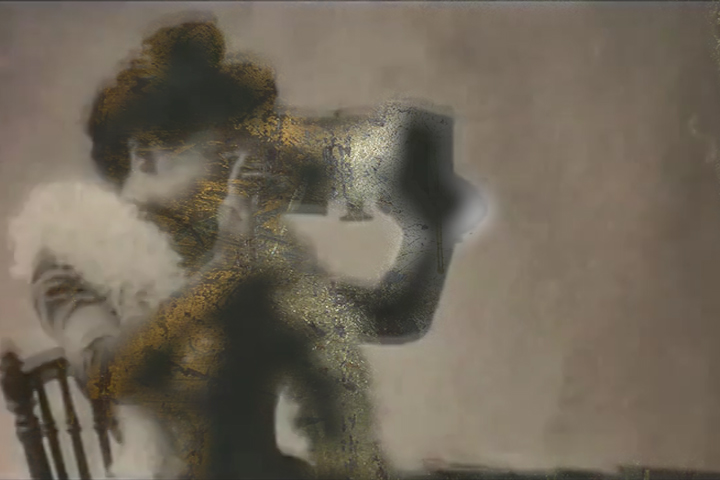
An image from Zlatko Cosic’s video tribute of Alice Guy Blache shows an image of the filmmaker as a young woman. (Courtesy Rita Csapo-Sweet)
Before Steven Spielberg, James Cameron, George Lucas and others were hailed as innovative directors, there was Alice Guy-Blaché.
The French woman was a pioneer in the film industry, and her work is being given new life thanks to the collaboration of two University of Missouri–St. Louis professors.
“The Birth, the Life and the Death of Christ” will be shown at 2:30 p.m. Sunday, Nov. 16, at the Saint Louis Art Museum as part of the St. Louis International Film Festival. The showing will feature an original score composed by Curators’ Professor of Music Barbara Harbach and a multimedia presentation developed by Associate Professor of Media Studies Rita Csapó-Sweet. Professor of Music Jim Richards will conduct Harbach’s piece for 13 members of the Saint Louis Chamber Orchestra.
At more than a century old, “The Birth, the Life and the Death of Christ” has significance not just for its place in women’s film history, but in film overall. Guy-Blaché made the 35-minute film in 1906, at a time when most films were only a few minutes long. The film is also the first known example of narrative storytelling, rather than documentary filmmaking.
“Alice Guy-Blaché took cinema out of the documentary form and turned it into something that could be compared to literature or theater,” Csapó-Sweet said.
The event will also involve an experimental multimedia tribute to Guy-Blaché by St. Louis video artist Zlatko Cosic. The five-minute tribute features an original score composed and performed by Brad Decker, and photographs by Csapo-Sweet.
Guy-Blaché worked as a secretary in France for camera innovator Léon Gaumont. After attending a film exposition with Gaumont in 1895, she became interested in the technology herself and asked her boss if she could use it to tell stories.
Guy-Blaché made numerous movies in France at the Gaumont Film Company before moving to New Jersey and opening her own studio, Solax Studios. She is also believed to be the creator of the close-up and the job of director. Most of the nearly 1,000 films she made have been lost due to deterioration of their materials. The Library of Congress houses what remains of her collection.
Harbach’s score is a modern take on the tradition of theaters of the time incorporating live music with silent films. She and Csapó-Sweet have collaborated on silent films in the past, including “Making an American Citizen.”
“I am often inspired by film, literature and poetry,” Harbach said. “In the case of film, I intently watch the film many times and try to capture the underlying pathos and translate that to music.”
Like many female filmmakers of the era, their stories have been largely written out of history books, Csapo-Sweet said.
“There were some women in early cinema – as long as cinema was seen as frivolous or not serious the men kind of ignored them,” she added. “When it became clear that cinema makes money, and potentially a lot of money, that’s when the women were one by one eased out of the business.”
Female filmmakers took on a lot of serious subjects that male counterparts were reluctant to tackle, such as child slavery, birth control, domestic violence and prostitution. Guy-Blaché’s take on the story of the passion of the Christ is also different than many retellings due to its emphasis on the life of Jesus Christ as a person and the women who were in his life.
“I was inspired by the film, and almost all of the 25 scenes are focused on the women who surrounded Christ throughout his life,” Harbach said.















